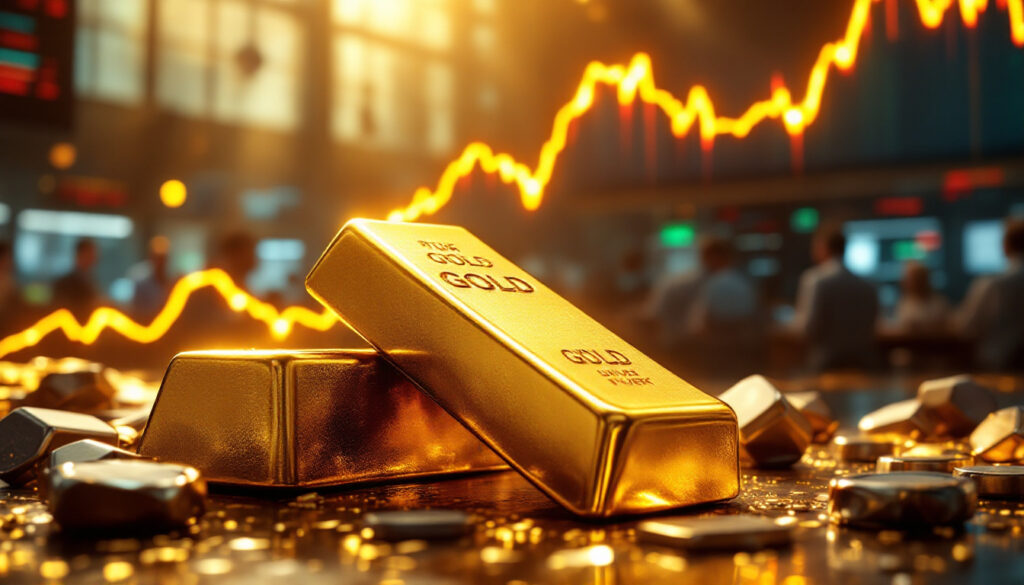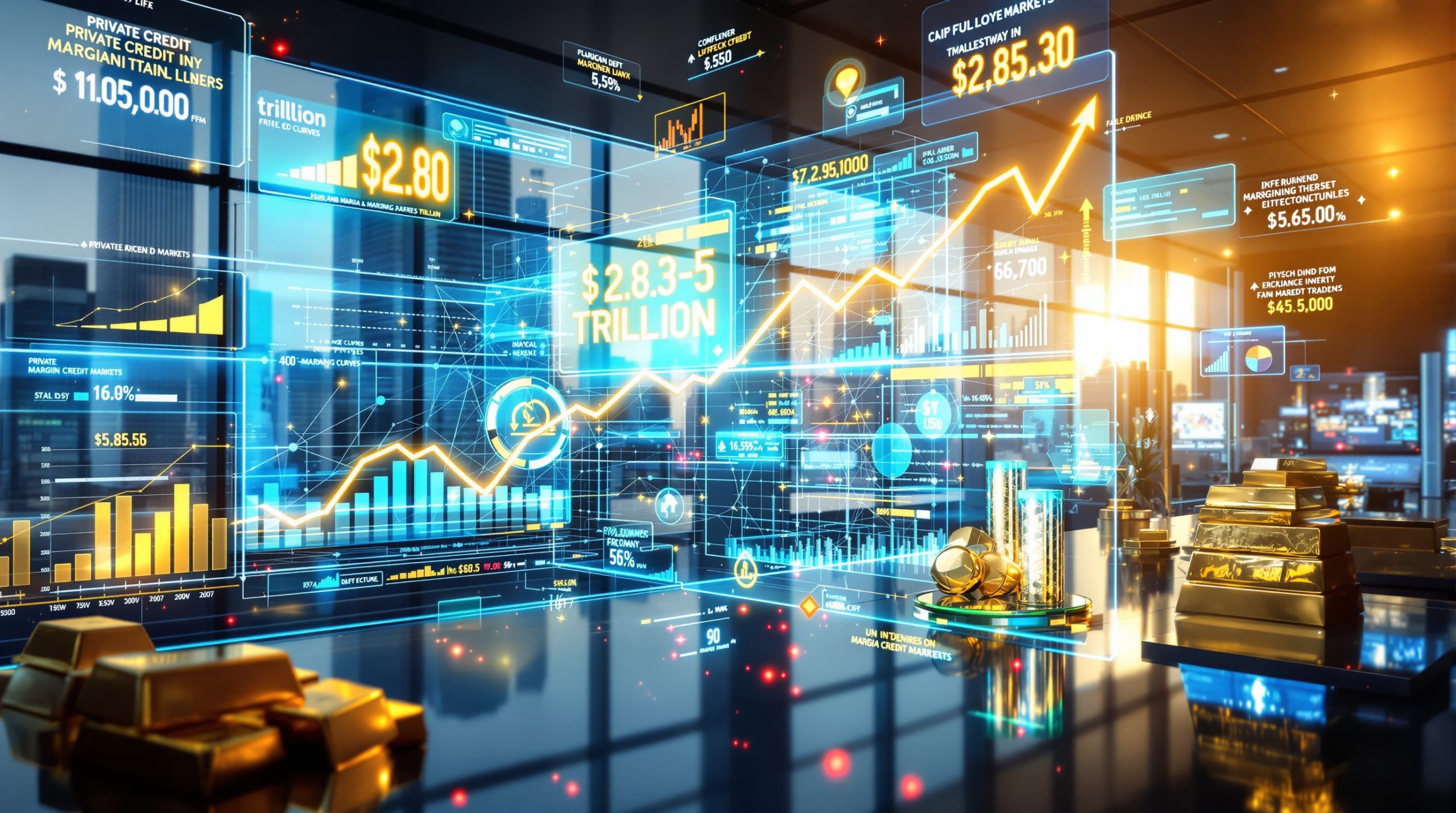What's Driving Current Gold and Silver Market Dynamics?
The precious metals market has entered a fascinating new phase, with gold reaching unprecedented gold price highs above $3,400 per ounce and showing strong momentum despite broader market volatility. This surge represents more than just a typical bull market—it signals a fundamental shift in how investors perceive traditional safe-haven assets amid growing economic uncertainty.
Gold's remarkable performance through May 2025 highlights a significant change in market dynamics, as institutional investors increasingly seek alternatives to traditional financial assets.
Key Market Indicators Shaping Precious Metals
Recent technical analysis shows gold breaking through significant resistance levels that had constrained prices for years. After multiple tests of the $2,000 level between 2020-2023, gold finally established a decisive breakout pattern in 2024, confirming a major trend change that technical analysts had anticipated based on momentum indicators rather than just price action.
"Gold has consistently outperformed major equity indices year-to-date, signaling institutional capital reallocation," notes market analyst Michael Oliver. This outperformance reflects growing concerns about structural weaknesses in traditional markets.
Meanwhile, silver presents a compelling case study in relative underperformance against gold, with the silver-to-gold ratio hovering near historically low levels around 1% (meaning silver is priced at approximately 1% of gold's value). This extreme reading has typically preceded significant silver market squeeze events in previous market cycles.
"Silver's current ratio to gold is 'dirt cheap' and historically precedes significant price movements," explains Oliver. "When we see silver this undervalued relative to gold, it often sets up powerful reversals."
This ratio perspective offers a unique lens for understanding potential opportunities in the precious metals space, especially when viewed against the backdrop of previous bull markets like 1979-1980 and 2010-2011, when silver reached over 3% of gold's value.
How Are Stock Market Conditions Influencing Precious Metals?
Technical Breakdown of Equity Markets
Major equity indices have shown concerning technical deterioration despite their impressive nominal gains. The S&P 500's momentum indicators began showing significant weakness in early 2025, with quarterly momentum structures breaking down even as prices continued making marginal new highs. After peaking around 6,100-6,200 in January 2025, the index retreated to approximately 4,800 by April.
"Equity market momentum breakdowns in early 2025 signal a multi-year bear trend, mimicking 2000 and 2007 patterns," Oliver observes. This deterioration beneath the surface creates an environment where precious metals often thrive as alternative stores of value.
This pattern of deteriorating technical strength beneath seemingly positive price action mirrors previous major market tops. Historical precedent suggests that once these momentum structures break, markets typically don't immediately crash but instead enter a period of increased volatility and failed rallies before more substantial declines materialize.
Capital Flight and Asset Reallocation
A notable shift in institutional capital flows has begun, with some international pension funds publicly announcing reductions in U.S. market exposure. Danish pension funds, for example, have recently reduced their allocation to U.S. equities, signaling growing international concern about market stability.
This capital reallocation process typically accelerates once technical breakdowns confirm trend changes, creating a self-reinforcing cycle:
- Initial technical breakdowns trigger cautious repositioning
- Early capital flight exacerbates technical weakness
- More investors recognize the trend change and reallocate assets
- Traditional safe havens like gold receive increasing capital flows
"Asset managers are reallocating to gold as S&P gains prove unsustainable," notes Oliver. This process helps explain why gold has consistently outperformed major equity indices on a year-to-date basis, despite mainstream financial media focusing primarily on stock market gains.
Why Is Silver Positioned for Potential Outperformance?
Silver's Technical Setup and Historical Context
Silver's price action has created a compelling technical pattern that suggests significant upside potential:
- Three distinct tests of the $35 level (May 2024, October 2024, March 2025)
- Rapid recovery from sharp corrections
- Formation of a potential "triple top" pattern that often serves as a launching pad in silver markets
- Long-term momentum indicators showing a year-long gradual downtrend channel ready for a potential breakout
"A breakout above $35 would trigger a momentum-driven surge, challenging Goldman Sachs' bearish outlook," Oliver predicts. The technical structure suggests that once silver clears this resistance, the move could accelerate significantly.
From a historical perspective, silver has traded at approximately 2% of gold's price in 21 out of the last 50 years, suggesting the current ratio near 1% represents significant undervaluation. During previous precious metals bull markets (1979-1980 and 2010-2011), silver reached over 3% of gold's price.
Industrial Demand vs. Investment Demand
While some major financial institutions have recently expressed skepticism about silver's potential to match gold's performance (citing industrial demand concerns), technical analysis suggests the market may be preparing for a significant sentiment shift. A decisive move above $35 could trigger a momentum-based breakout that fundamentally changes silver's performance relative to gold.
"Silver's current 1% ratio to gold is a 'slingshot' setup for explosive gains," explains Oliver, highlighting the metal's potential for dramatic outperformance once key technical levels are breached.
The 2011 silver rally demonstrates this potential, when prices surged from $30 to $50 in just five months after a similar technical breakout pattern resolved to the upside.
What's Happening with Mining Stocks?
Relative Performance and Valuation Metrics
Mining stocks present another compelling value proposition within the precious metals sector. Despite underperforming gold over recent quarters, major mining indices like GDX have actually outperformed gold since the December 2015 sector lows on a percentage basis.
Current metrics highlight the value proposition:
- Many major producers operating at all-in sustaining costs (AISC) around $1,150 per ounce
- Gold prices approximately 200% higher than production costs
- Mining stocks trading at historically low valuations relative to gold
This disconnect between operational profitability and stock performance suggests significant potential for undervalued mining stocks to outperform the underlying metals as the bull market matures and institutional capital increasingly seeks exposure to the sector.
The mining sector needs approximately a 0.5% relative performance breakout versus gold to confirm a major trend change, according to technical analysis. Such a confirmation would likely attract additional institutional investment, potentially accelerating mining stock outperformance.
How Are Bond Markets and Currency Trends Affecting Precious Metals?
Bond Market Dynamics and Yield Implications
The bond market has experienced unprecedented volatility, with the 10-year Treasury yield spiking significantly and creating what some analysts describe as "mini-crash" conditions in bond prices during April 2025. This behavior is highly unusual for Treasury bonds, which have historically provided a reliable safe haven during equity market stress.
"Treasury bonds lost safe-haven status, redirecting capital to gold," notes Oliver. This fundamental change in market behavior creates a powerful tailwind for precious metals as they increasingly become the default safe-haven asset class.
This dysfunction in the traditional "flight to quality" relationship between stocks and bonds has profound implications for precious metals:
- It eliminates a major competing safe-haven asset class
- It raises questions about the sustainability of government debt levels
- It creates additional uncertainty that typically benefits monetary metals
Dollar Weakness and International Implications
The U.S. Dollar Index has broken significant long-term technical support levels, declining from around 110 in 2024 to below 100 in 2025. This breakdown on annual momentum charts suggests the potential beginning of a major bear trend in the dollar, which historically correlates with strength in precious metals.
"Dollar's breakdown below 100 signals a multi-year bear trend," Oliver warns. This technical development represents the first major annual momentum breakdown since 2015, potentially signaling a new secular trend in currency markets.
For international investors, this currency weakness compounds the negative performance of U.S. assets. A foreign investor not only experiences losses from declining asset prices but also from the eroding value of the dollar itself, creating a powerful incentive to seek alternative stores of value.
What Factors Could Trigger the Next Major Move in Precious Metals?
Potential Catalysts for Acceleration
Several key technical levels and market conditions could serve as catalysts for the next significant move in precious metals:
- Silver breaking decisively above $35 per ounce
- Mining stocks improving their relative performance versus gold by approximately 0.5%
- The S&P 500 dropping below its recent lows around 4,800
- Further deterioration in bond market functioning
- Continued dollar weakness below the psychologically important 100 level
The convergence of these factors could create a powerful environment for precious metals, potentially triggering a phase of dramatic outperformance relative to traditional financial assets.
Broader Economic and Geopolitical Context
The precious metals market exists within a complex web of economic and geopolitical factors that could influence price trends:
- Commercial real estate stress and potential loan defaults
- Questions about long-term government debt sustainability
- Geopolitical tensions and their impact on global trade
- Central bank credibility and monetary policy effectiveness
- Commodity market dynamics, particularly in energy markets
These factors create a backdrop of uncertainty that typically benefits monetary metals as investors seek assets perceived to maintain value during periods of institutional stress.
What Does Technical Analysis Suggest About Oil Prices?
Oil's Technical Structure and Inflation Implications
Oil presents an interesting technical picture that could have significant implications for inflation expectations and, by extension, precious metals markets:
- WTI crude oil has broken through long-established support around $65
- Recent price action suggests a potential "bear trap" formation
- A decisive move back above $65 would signal a potential trend change
- A move toward $72 could trigger a major momentum breakout
This technical setup suggests oil trade war dynamics may be poised for a significant rally, contradicting current market expectations for continued moderate energy prices. Such a move would likely reignite inflation concerns and potentially accelerate interest in inflation-hedging assets like gold and silver.
Energy prices remain a critical driver of inflation psychology, which directly influences precious metals demand. Despite recent weakness, oil's technical structure suggests potential for a significant reversal that could dramatically alter market perceptions around inflation risks.
How Might Market Bubbles Impact Precious Metals?
Bubble Psychology and Aftermath Effects
The current market environment displays many characteristics of historical bubble formations, with extreme valuations, narrow leadership, and deteriorating technical foundations beneath seemingly strong price action. The NASDAQ 100's 82% drop in 2000-2002 required 16 years to recover, demonstrating the potential long-term implications of major market bubbles.
When such bubbles ultimately deflate, the process typically follows a pattern:
- Initial breakdown and disbelief
- Rally attempts that fail at lower highs
- Gradual acceptance of the new trend
- Potential capitulation phase with accelerated selling
"Post-bubble environments see investors question financial orthodoxies, favoring hard assets like gold," observes Oliver. This psychological shift can fundamentally alter market dynamics for years or even decades.
This process creates ripple effects throughout the financial system, often leading to:
- Questioning of previously accepted financial orthodoxies
- Loss of faith in traditional financial institutions
- Search for alternative stores of value
- Potential regulatory and policy responses
Historical precedent suggests precious metals often perform strongly during these periods of institutional questioning and financial system stress. During the 2008 financial crisis, for example, gold rose approximately 25% while the S&P 500 fell 38%, highlighting the divergent performance during systemic stress.
What Investment Strategies Should Precious Metals Investors Consider?
Portfolio Positioning and Risk Management
Given the technical evidence and historical context, investors might consider several approaches to precious metals exposure:
- Maintaining core positions in physical gold as a foundation
- Adding silver exposure for potential outperformance
- Including select mining equities for additional leverage to metal prices
- Implementing a disciplined approach to position sizing and risk management
- Recognizing that corrections, even sharp ones, are normal features of bull markets
"Core physical gold + tactical silver/miners exposure balances stability and upside," advises Oliver. This balanced approach provides both defensive positioning and significant upside potential as the bull market matures.
The evidence suggests we may be in the early stages of a significant revaluation of precious metals relative to financial assets, with potential for dramatic price movements as institutional capital increasingly seeks exposure to the sector.
Technical Indicators to Monitor
Investors should watch several key technical indicators to confirm or challenge the bullish thesis:
- Relative performance of silver versus gold
- Mining stock performance relative to underlying metals
- Dollar index movements, particularly around the 100 level
- Bond market functioning and yield trends
- Oil price movements as a potential inflation catalyst
These indicators can provide early warning signs of changing market dynamics and help investors adjust positioning accordingly.
FAQs About Gold and Silver Market Trends
Why has gold outperformed major stock indices recently?
Gold has outperformed major stock indices as institutional investors seek alternatives to traditional financial assets amid growing concerns about market valuations, economic stability, and currency debasement. Technical breakdowns in equity market momentum have accelerated this capital reallocation process.
"Gold's outperformance reflects institutional distrust in equity momentum," explains Oliver, highlighting the fundamental shift in market psychology driving capital toward precious metals.
What explains silver's underperformance relative to gold?
Silver has underperformed gold during this cycle partly due to its dual nature as both a precious and industrial metal. Economic slowdown concerns have weighed on its industrial component, while its monetary aspects have supported prices. This has created a historically low silver-to-gold ratio that typically precedes significant silver outperformance.
"Silver's underperformance stems from industrial demand fears, but technicals favor reversal," notes Oliver. This divergence between fundamental concerns and technical setup creates a potential opportunity for investors.
How do mining stocks typically perform in precious metals bull markets?
Mining stocks typically underperform in the early stages of precious metals bull markets but deliver significant outperformance as the cycle matures. Their operational leverage to metal prices creates the potential for dramatic gains once institutional investors recognize the sector's value proposition and begin allocating capital accordingly.
What role does the U.S. dollar play in precious metals pricing?
The U.S. dollar typically shows an inverse relationship with precious metals prices. Recent technical breakdowns in the dollar index suggest the potential beginning of a major bear trend, which historically correlates with strength in gold and silver. This relationship reflects precious metals' role as alternative currencies during periods of fiat currency weakness.
How might commercial real estate stress impact precious metals markets?
Commercial real estate stress could create significant pressure on the banking system and broader financial markets, potentially triggering a flight to quality that benefits precious metals. The sector's high leverage and sensitivity to US economy tariffs make it particularly vulnerable in the current environment, creating systemic risk that typically supports safe-haven assets.
Disclaimer: This article contains market analysis and forecasts that represent opinions and are speculative in nature. Investors should conduct their own research and consult with financial professionals before making investment decisions based on the information presented.
Want to Identify the Next Major Mineral Discovery?
Discovery Alert's proprietary Discovery IQ model delivers real-time alerts on significant ASX mineral discoveries, instantly empowering subscribers to identify actionable opportunities ahead of the broader market. Visit our discoveries page to understand why historic mineral discoveries can generate substantial returns and begin your 30-day free trial today.




